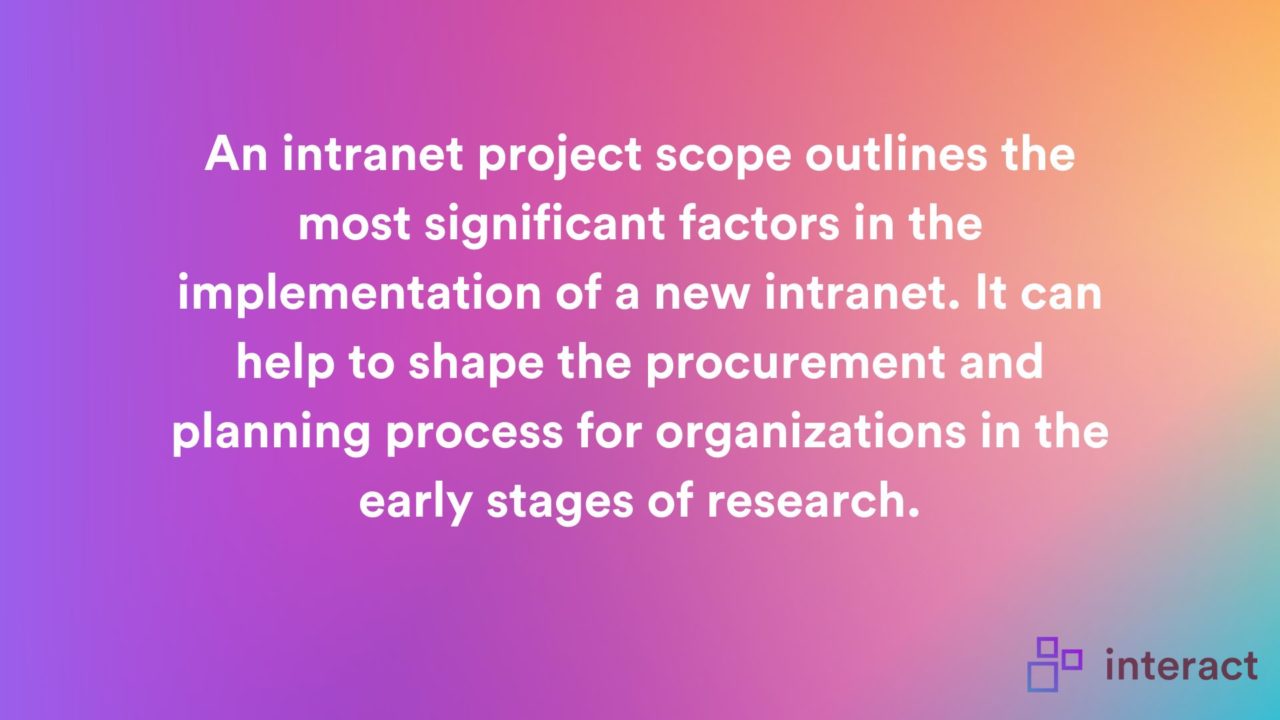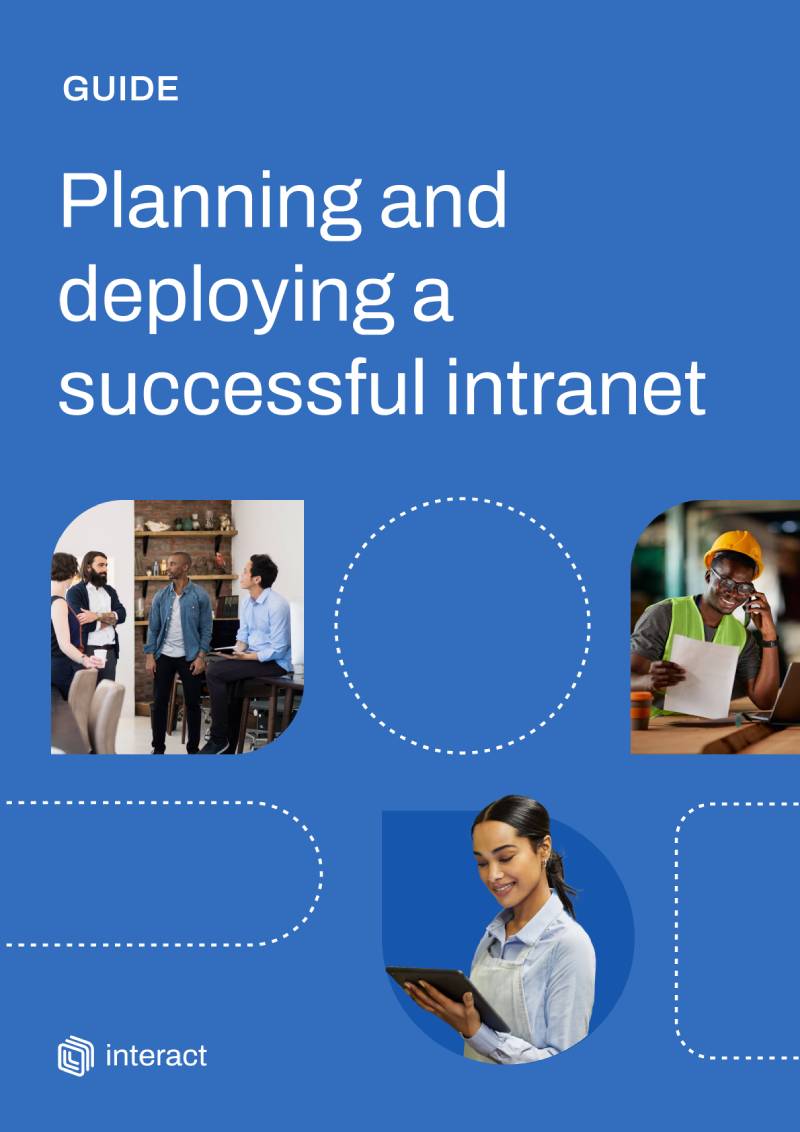Implementing a new intranet requires time and resources that no organization wants to waste. But how can you be sure the project will be feasible? An intranet project scope statement can help you outline your plans. Here are the 8 elements you need to include in the first stage of intranet planning.
Why do organizations decide they need a new intranet?
There’s no single reason. In some cases, a person with experience of successful intranets may join an organization and see an opportunity for improvement in workplace communication.
Conversely, a critical event, such as the pandemic, can force a company to re-evaluate how it communicates with its workforce. When fault lines in communication, culture, or engagement are exposed, the organization may decide it needs to optimize technology or change its technology and approach.
For example, if you need to warn 1,000 frontline workers with no access to laptops not to go to their regular work locations – but the only technology you have is email – it may be time for a multichannel communications solution.

No matter how this inflection point arises, you will be aware that something needs to change. You may think that an intranet is the right next step, but before you do the work needed for a lengthy business case, an intranet project scope statement can be a high-level way to stress test your ideas and share them with key decision-makers.
The ultimate guide to intranet planning
You can then expand on the work included in the intranet project scope in your intranet project proposal, business case, intranet strategy, and more.
Project scope definition
The term “project scope” (sometimes called a scoping document or project scope statement) comes from professional project management.
It is a repeatable template produced in the early stages of a collaborative project. Indeed.com has a neat definition.
“A project scoping document outlines all the significant boundaries of a project so both team members and customers understand what it does and doesn’t entail.”
The purpose of a scoping plan is to assess the objectives, challenges, and deliverables in a potential project.
With these factors laid out, an organization can either make the decision to press ahead, to alter a plan, or that it’s not in its best interest to proceed at all.
Intranet project scope definition

Whatever your reason for considering a new intranet platform, an intranet project scope statement can inform how you research your options and make an intranet business case.
You want to find the best intranet, but “best” depends on your needs and objectives. A project scope can be your first way of understanding what those goals are. It can also give you a clear path to knowing exactly what you need.
This is important because there are many different types of intranet software and there is no solution that fits all scenarios.
Most organizations don’t have large in-house IT teams, for example, so self-building a SharePoint intranet may be impractical. A specialist internal comms software vendor with project delivery expertise on the other hand may be a better fit.
Use your project scope to understand your needs in this regard.
A scoping document is not a project plan
A project scope is the first step in the planning process, but it will not encompass all the possible steps, stakeholders, and deliverables.
A fully formed project plan will be much closer to a formal Statement of Work, which you may receive from an intranet vendor, collaborate on, or devise alone if you are custom-building a new platform.
The Statement of Work will contain more details on the how and why your project will be designed and implemented. It may contain more detailed information on dates, users, tech integrations, training, and comms.
Scoping statement example
Here are 8 key sections you should use in an outline. We’ve added some intranet specific ideas to get you started.
1. Intranet project overview
This should include your top-level goals. How will a new intranet transform your organization for the better?
This project scope is to determine the feasibility of replacing the company’s existing SharePoint intranet with a modern intranet capable of multichannel communication.
The goal is to upgrade employee communications and experience by providing all staff with a user-friendly, searchable intranet platform capable of personalization. The new platform will offer desktop, responsive, and mobile app experiences, and will connect all employees via a range of communications channels.
2. Business case
Convincing financial decision-makers is an important part of any workplace project. Although you will develop your intranet business case more fully in a separate document, the scoping plan should include some specific, measurable outcomes.
The company’s legacy SharePoint intranet and associated comms tools (including platforms for email, surveys, and digital signage cost $500,000 annually in IT resources, outside consultancy, and user licenses. Initial research suggests that a modern intranet may only cost half of this amount through the streamlining of multiple systems and resources to one main platform controlled by the existing Internal Communications team. A single platform would also reduce burden on IT and HR and free up resources to work on valuable strategic initiatives.
3. Project deliverables
What is the intended outcome at the end of the project? This section will be more detailed in a Statement of Work or full project plan, but this stage may include a high-level description of expectations.
The build, design, and implementation of a modern intranet platform for 20,000 employees.
50% of users are based in home or office locations and 50% are based in frontline locations, including warehouses and transport. The new site will be a cloud-based intranet capable of multilingual and multichannel communication.
The company will provide internal resources to work with a vendor on the design, integration, and creation of the intranet and its content.
As dictated by best practice, the intranet build will take place in three main sections. The initial creation of a Minimum Viable Product (MVP) site, a rollout to a subset of 50% of total users, and a global rollout to all users. Each section will have a separate set of deliverables.
4. Acceptance criteria
If you are the intranet project manager for your company, which criteria must be met before the project is complete? The below statement is an outline of process and may give you some idea of how an intranet project can be rolled out.
In accordance with project management best practice, the acceptance criteria for the new platform will be set out in detail before each of the three stages. Criteria at each stage will include creation and delivery of a detailed project plan, strategy, governance, design, technical integrations and specification, build, training, and information architecture.
Each stage’s deliverables will be signed off by the Intranet Project Manager, the IT Lead, and the Vendor.
5. Project constraints
You may be aware in advance that your intranet must be functional within 3 months or that there is some other limiting factor that may impact delivery. The intranet project scope is the place to outline those issues.
The move of the company’s headquarters in Q2 will require significant input from IT and Internal Communications. Delaying the start of the intranet project until Q3 or Q4 may give better access to internal resources.
6. Assumptions
If you are new to intranet planning and have not yet begun speaking with specialist vendors, there will be many unknown factors. In the case of intranet implementation, it is worth thinking about your intended number and spread of users, your organization’s technical requirements, and the delivery of other projects.
This project will be delivered through the engagement of an intranet software company experienced in delivering enterprise-grade platforms. We assume their knowledge and support for a technical integration with a M365-based digital workplace and priority integration with Workday.
Up to 2 hours a week of IT resource may be needed for the duration of the project, along with a full-time Intranet Project Manager and the support of one full-time internal content specialist to support with content migration and/or build.
The company is expected to open three new offices in Asia this year. This will add a further 1,500 employees and mean that the new intranet will need to serve a wider audience. The plan will need to include the additional headcount in the business case.
7. Exclusions
This section covers anything you believe will not be included in the project. This may include add-on features that are not included in a SaaS pricing model.
At present, the paid-for Advanced Analytics feature is not included in the plan due to the need for an internal Business Intelligence resource. When the Business Intelligence team expands and more time is available the plan is to integrate the intranet with PowerBI and to expand the possibilities enabled by this.
8. Agreement
The simplest section. You’ve done the hard work, now you just need to brief the relevant stakeholders and have them review and sign your scoping plan!
Start your journey here
The purpose of creating this first intranet project scope is to outline the essential factors before a great deal of work or capital is invested in the project. Working this way is also highly collaborative because you are engaging stakeholders before any work begins.
Imagine the wasted time if you created an entire intranet business case only to discover that the IT team had already found a new solution.
Unless you are a highly experienced intranet project manager, most of the material in this document will be generalized. Don’t let that stop you from creating this early stage-document, however, as laying it out on the page will help you to understand a great deal of key information. You will learn what you want from the platform, some key planning decisions (such as whether you need an intranet proof of concept), and which is the best partner for your organization.


